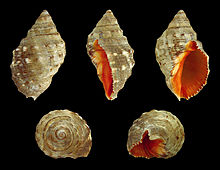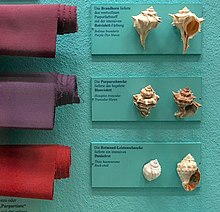Stramonita haemastoma
| Stramonita haemastoma | |
|---|---|

| |
| Stramonita haemastoma shell | |
| Scientific classification | |
| Kingdom: | |
| Phylum: | |
| Class: | |
| (unranked): | |
| Superfamily: | |
| Family: | |
| Subfamily: | |
| Genus: | |
| Species: | S. haemastoma
|
| Binomial name | |
| Stramonita haemastoma (Linnaeus, 1767)
| |
| Synonyms[1] | |
| |
Stramonita haemastoma, common name the red-mouthed rock shell or the Florida dog winkle, is a species of predatory sea snail, a marine gastropod mollusc in the family Muricidae, the rock snails.[1]
Subspecies[edit]
Stramonita haemastoma contains the following subspecies:[1][2]
- Stramonita haemastoma canaliculata (Gray, 1839): synonym of Stramonita canaliculata (Gray, 1839)
- Stramonita haemastoma floridana (Conrad, 1837): synonym of Stramonita floridana (Conrad, 1837) (unaccepted rank)
- Stramonita haemastoma haemastoma (Linnaeus, 1767): synonym of Stramonita haemastoma (Linnaeus, 1767)
Distribution[edit]
The red-mouthed rock shell occurs widely in tropical and warm water areas of the Western Atlantic Ocean. Regions where it can be found include the Caribbean Sea, North Carolina and Florida, Bermuda and the entire Brazilian coast, including the islands of Abrolhos and Fernando de Noronha. It is also found in the Eastern Atlantic: tropical Western Africa and Southwestern Africa, including Cape Verde and Angola, and in European waters, including Macaronesian Islands, the Mediterranean Sea and the southwest coast of Apulia.[1][3][4] Its once abundant population in the Eastern Mediterranean collapsed early in the 21st century and had entirely disappeared by 2016.[5][6]
Description[edit]
The adult shell size for this species varies between 22 mm and 120 mm.
This section needs expansion. You can help by adding to it. (January 2011) |
Feeding habits[edit]
Stramonita haemastoma is a widespread gastropod that consumes bivalves, barnacles and limpets. In the Mediterranean Sea the whelk is an important predator of the bivalve Mytilaster minimus, but where the invasive Lessepsian migrant bivalve Brachidontes pharaonis is found, the whelk prefers to prey on that species over the native bivalves and barnacles.[7] Through feeding behaviors such as attacking the margin or lip of shells where defenses are weakest, Stramonita haemastoma insert its proboscid between the valves injecting proteolytic enzymes and a toxin that causes bivalves to gape.[2][8]
Human use[edit]

The shell was one of two principal sources of Tyrian purple, a highly prized dye used in classical times for the clothing of royalty, as recorded by Aristotle and Pliny the Elder.[5]
References[edit]
- ^ a b c d Stramonita haemastoma (Linnaeus, 1767). Retrieved through: World Register of Marine Species on 17 December 2018.
- ^ a b Watanabe, J.T. & Young, C.M. 2006. Feeding habits and phenotypic changes in proboscis length in the southern oyster drill, Stramonita haemastoma (Gastropoda: Muricidae), on Florida sabellariid worm reefs. Marine biology, 148:1021-1029.
- ^ Leal, J. H. (2002). "Gastropods" (PDF). In Carpenter, K. E. (ed.). The living marine resources of the Western Central Atlantic. FAO Species Identification Guide for Fishery Purposes and American Society of Ichthyologists and Herpetologists Special Publication No. 5. Vol. 1: Introduction, molluscs, crustaceans, hagfishes, sharks, batoid fishes, and chimaeras. Rome: FAO. pp. 128–132. ISBN 978-92-5-104825-2.[permanent dead link]
- ^ "Conquiliologistas do Brasil". Thais haemastoma (Linnaeus, 1767). 2001–2010. Retrieved 3 April 2010.
- ^ a b Beaumont, Peter (5 December 2016). "Ancient shellfish used for purple dye vanishes from eastern Med". BBC. Retrieved 6 December 2016.
- ^ Rilov, Gil (17 November 2016). "Multi-species collapses at the warm edge of a warming sea". Scientific Reports. 6: 36897. doi:10.1038/srep36897. PMC 5113072. PMID 27853237.
- ^ Giacoletti, A., Rinaldi, A., Mercurio, M., Mirto, S. and Sarà, G. 2016. "Local consumers are the first line to control biological invasions: a case of study with the whelk Stramonita haemastoma (Gastropoda: Muricidae)". Hydrobiologia. 772:117–129.
- ^ McGraw, K.A., Gunter, G. 1972. Observations on killing of the Virginia oyster by the gulf oyster borer, Thais haemastoma, with evidence for a paralytic secretion. Proc Nat Shellfish Assoc 62:95–97.
Further reading[edit]
- Bernard, P.A. (Ed.) (1984). Coquillages du Gabon [Shells of Gabon]. Pierre A. Bernard: Libreville, Gabon. 140, 75 plates
- Gofas, S.; Afonso, J.P.; Brandào, M. (Ed.). (S.a.). Conchas e Moluscos de Angola = Coquillages et Mollusques d'Angola. [Shells and molluscs of Angola]. Universidade Agostinho / Elf Aquitaine Angola: Angola. 140 pp
- Gofas, S.; Le Renard, J.; Bouchet, P. (2001). Mollusca, in: Costello, M.J. et al. (Ed.) (2001). European register of marine species: a check-list of the marine species in Europe and a bibliography of guides to their identification. Collection Patrimoines Naturels, 50: pp. 180–213
- Rolán E., 2005. Malacological Fauna From The Cape Verde Archipelago. Part 1, Polyplacophora and Gastropoda
- Rosenberg, G., F. Moretzsohn, and E. F. García. 2009. Gastropoda (Mollusca) of the Gulf of Mexico, Pp. 579–699 in Felder, D.L. and D.K. Camp (eds.), Gulf of Mexico–Origins, Waters, and Biota. Biodiversity. Texas A&M Press, College Station, Texas.
- Ramírez R., Tuya F. & Haroun R. J. (2009) "Spatial patterns in the population structure of the whelk Stramonita haemastoma (Linnaeus, 1766) (Gastropoda: Muricidae) in the Canarian Archipelago (eastern Atlantic)". Scientia Marina 73(3) doi:10.3989/scimar.2009.73n3431
- Claremont M., Williams S.T., Barraclough T.G. & Reid D.G. (2011) The geographic scale of speciation in a marine snail with high dispersal potential. Journal of Biogeography 38: 1016-1032.
- Claremont M., Vermeij G.J., Williams S.T. & Reid D.G. (2013) Global phylogeny and new classification of the Rapaninae (Gastropoda: Muricidae), dominant molluscan predators on tropical rocky seashores. Molecular Phylogenetics and Evolution 66: 91–102.
- Scheltema R. (1971). Larval dispersal as a means of genetic exchange between geographically separated populations of shallow-water benthic marine Gastropods. Biological Bulletin 140: 284-322
- Garrigues B. & Lamy D. (2019). Inventaire des Muricidae récoltés au cours de la campagne MADIBENTHOS du MNHN en Martinique (Antilles Françaises) et description de 12 nouvelles espèces des genres Dermomurex, Attilosa, Acanthotrophon, Favartia, Muricopsis et Pygmaepterys (Mollusca, Gastropoda). Xenophora Taxonomy. 23: 22-59.
External links[edit]
- "Stramonita haemastoma haemastoma". Gastropods.com. Retrieved 10 January 2011.
- Linnaeus, C. (1767). Systema naturae per regna tria naturae: secundum classes, ordines, genera, species, cum characteribus, differentiis, synonymis, locis. Ed. 12. 1., Regnum Animale. 1 & 2. Holmiae
- Dunker, W. (1857). Mollusca nova collectionis Cumingianae. Proceedings of the Zoological Society of London. 24: 354-358
- Calcara P. (1840). Monografie dei generi Clausilia e Bulimo coll'aggiunta di alcune nuove specie di conchiglie siciliane esistenti nella collezione della Sig. Teresa Gargotta in Salinas. Palermo, Muratori 54 p
- Reeve, L. A. (1846). Monograph of the genus Purpura. In: Conchologia iconica, or, illustrations of the shells of molluscous animals, Vol. 3. L. Reeve & Co., London. Pls. 1-13 and unpaginated text
- Conrad, T. A. (1837). Description of new marine shells, from Upper California. Collected by Thomas Nuttall, Esq. Journal of the Academy of Natural Sciences, Philadelphia. 7: 227-268, pls 17-20.
- Locard, A. (1886). Prodrome de malacologie française. Catalogue général des mollusques vivants de France. Mollusques marins. Lyon: H. Georg & Paris: Baillière. x + 778 pp.
- Lamarck, J. B. P. A. de M. de. (1816). Tableau encyclopédique et méthodique des trois règnes de la nature, Mollusques et polypes divers. Part 23
- Philippi, R. A. (1844). Enumeratio molluscorum Siciliae cum viventium tum in tellure tertiaria fossilium, quae in itinere suo observavit. Vol. 2.. Halle
- Bucquoy E., Dautzenberg P. & Dollfus G. (1882-1886). Les mollusques marins du Roussillon. Tome Ier. Gastropodes. Paris: Baillière & fils. 570 pp., 66 pls
- Kobelt, W. (1887-1908). Iconographie der schalentragenden europäischen Meeresconchylien. 1: 1-171 pl. 1-28
- Röding, P.F. (1798). Museum Boltenianum sive Catalogus cimeliorum e tribus regnis naturæ quæ olim collegerat Joa. Fried Bolten, M. D. p. d. per XL. annos proto physicus Hamburgensis. Pars secunda continens Conchylia sive Testacea univalvia, bivalvia & multivalvia. Trapp, Hamburg. viii, 199 pp.
- Perry, G. (1811). Conchology, or the natural history of shells: containing a new arrangement of the genera and species, illustrated by coloured engravings executed from the natural specimens, and including the latest discoveries. 4 pp., 61 plates. London
- Gmelin J.F. (1791). Vermes. In: Gmelin J.F. (Ed.) Caroli a Linnaei Systema Naturae per Regna Tria Naturae, Ed. 13. Tome 1(6). G.E. Beer, Lipsiae (Leipzig). pp. 3021-3910.
